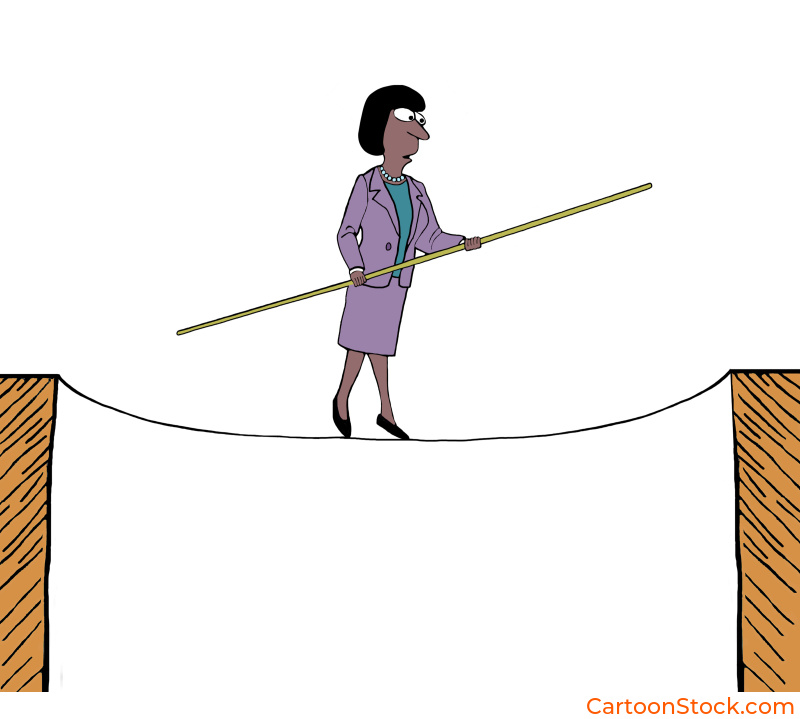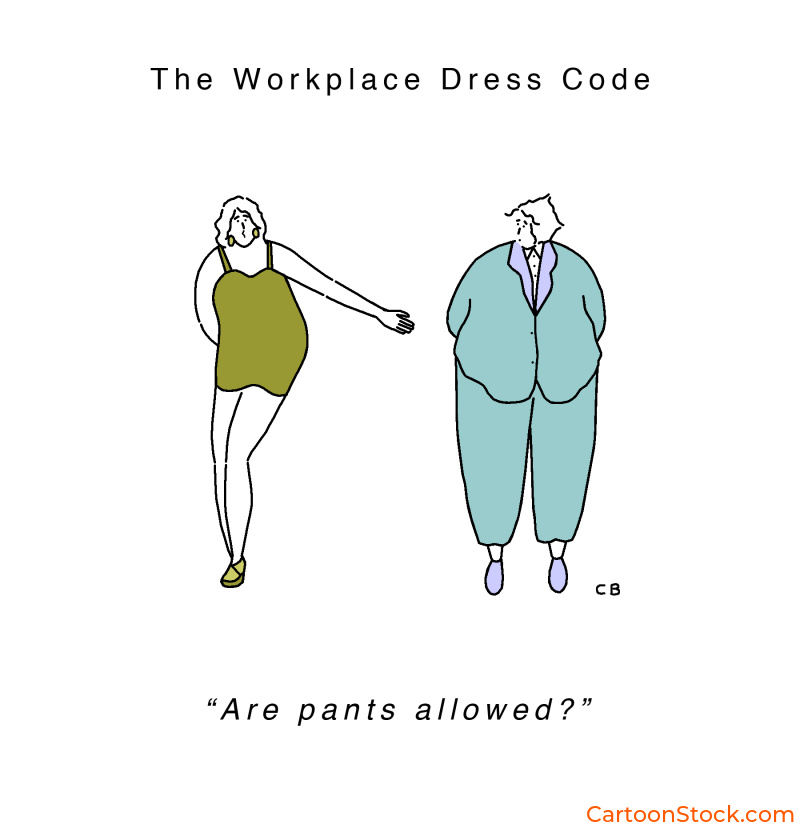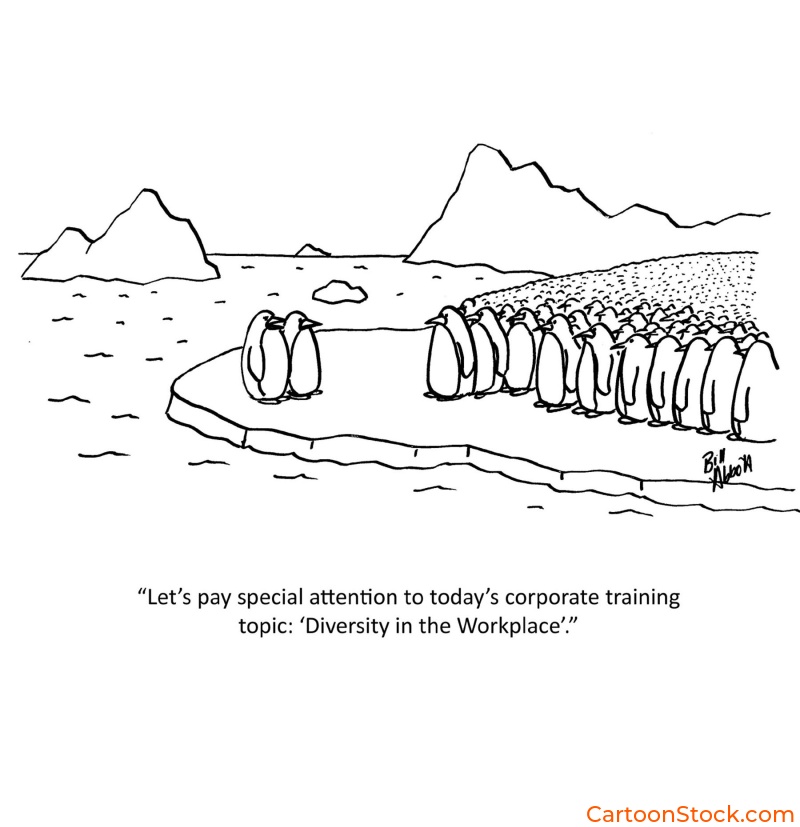Creating meaningful diversity, equity, inclusion, and belonging (DEIB) initiatives can feel overwhelming. Where do you start? How do you make training stick? How do you address sensitive topics without putting people on the defensive?
The answer might surprise you: using cartoons to support diversity and inclusion. This innovative approach is transforming how organizations tackle complex workplace issues, making sensitive topics more approachable and training more effective.
Using cartoons to support diversity and inclusion isn’t about making light of serious issues. It’s about making complex topics accessible, memorable, and genuinely engaging. When done right, cartoons can break down barriers, spark conversations, and create the psychological safety needed for real change.
This comprehensive guide shows you exactly how to integrate cartoons into your DEI strategy, from training sessions to company-wide communications.
Why Using Cartoons to Support Diversity and Inclusion Works So Well
Think about the last time you saw a cartoon that made you pause and think. Maybe it highlighted an uncomfortable truth or made you see something from a different perspective. That’s the power we’re talking about.
Cartoons work because they bypass our natural defenses. When someone presents data about workplace bias, we might argue with the statistics. When we see that same bias illustrated in a simple cartoon, we often recognize it immediately. The visual format makes abstract concepts concrete, while humor creates the emotional safety needed for difficult conversations.
Research shows that visual learning increases retention by up to 400%. Add humor to the mix, and you’ve got a combination that not only sticks but also builds the psychological safety essential for meaningful DEI work. People are more likely to engage with content that feels approachable rather than academic or preachy.
For DEI practitioners, this means cartoons can help you reach people who might otherwise tune out traditional training methods. They’re particularly effective for addressing microaggressions, unconscious bias, and systemic issues that can feel abstract or overwhelming when presented through text alone.
Creating Neurodiverse-Friendly Training Materials
When you’re designing DEI training, neurodiversity needs to be part of the conversation from day one. Traditional training methods often rely heavily on text-heavy presentations, long verbal explanations, and abstract concepts that can create barriers for neurodiverse learners.
Cartoons offer a different approach. They provide visual cues that support different learning styles, break complex information into digestible chunks, and reduce cognitive load. For employees with ADHD, autism, dyslexia, or other neurological differences, cartoons can make training more accessible and engaging.
The key is using cartoons strategically. Instead of overwhelming slides packed with bullet points, you might use a simple cartoon to illustrate a concept, then build the discussion around that visual anchor. This approach helps everyone process information more effectively, not just neurodiverse employees.
How to Create Neurodiverse-Friendly Workplace Training with Cartoons
Building Inclusion Through Visual Storytelling
Stories change minds. When you combine storytelling with visuals, you create something even more powerful: immediate recognition and emotional connection.
Using cartoons to support diversity and inclusion through storytelling means showing rather than telling. Instead of explaining what allyship looks like, you show it. Instead of defining microaggressions, you illustrate them. This approach helps people understand concepts viscerally, not just intellectually.
Visual storytelling with cartoons is particularly effective for highlighting everyday workplace scenarios. A cartoon showing someone being talked over in meetings, or illustrating how different communication styles can be misunderstood, resonates because most people have either experienced or witnessed these situations.
The beauty of this approach is that it invites self-reflection without pointing fingers. People can see themselves in the scenarios without feeling attacked or defensive. This creates the perfect environment for learning and growth.
How Businesses Can Use Cartoons to Foster Diversity & Inclusion
Making Policies Feel Human and Accessible
Let’s be honest: most workplace policies read like legal documents. They’re necessary, but they’re not exactly engaging. This is where cartoons can bridge the gap between policy and practice.
When you use cartoons to support diversity and inclusion in policy communication, you’re translating legalese into human terms. A cartoon showing what respectful communication looks like in practice is worth more than three paragraphs of policy text. It shows employees what the policy means in their daily work lives.
This approach is especially valuable for policies around harassment, inclusive language, and accommodation requests. These are often the policies that employees need to understand most clearly, but they’re also the ones most likely to be written in intimidating legal language.
Cartoons can illustrate the spirit of the policy, not just the letter of the law. They show employees what success looks like, making it easier to follow policies because they understand the why behind the what.
Making Workplace Policies More Inclusive with Cartoons
Building Belonging in Remote and Hybrid Teams
Remote and hybrid work environments present unique challenges for DEI efforts. How do you build belonging when people are scattered across different locations? How do you maintain inclusive culture when face-to-face interactions are limited?
Cartoons offer a solution that travels well across digital platforms. They work equally well in video calls, email communications, and collaboration tools. More importantly, they can address the specific challenges of remote work, like feeling isolated, dealing with different time zones, or navigating cultural differences across global teams.
Using cartoons to support diversity and inclusion in remote settings means creating shared visual language that everyone can understand, regardless of their location or background. A cartoon about inclusive meeting practices, for example, can remind everyone of best practices every time they join a video call.
The key is choosing cartoons that acknowledge the reality of remote work while promoting inclusive behaviors. This might mean addressing challenges like “Zoom fatigue” affecting people differently, or showing how to be inclusive of different home situations during video calls.
The Role of Cartoons in Building Belonging Across Hybrid & Remote Teams
How Cartoons Support Diversity and Inclusion Teams with Engaging Content
HR and DEI professionals are often tasked with communicating complex, sensitive topics to diverse audiences. You need content that works for everyone from senior executives to new hires, across different departments and cultural backgrounds.
Cartoons give you a versatile tool that can adapt to different contexts while maintaining your core message. A cartoon about unconscious bias works just as well in a C-suite presentation as it does in a new employee orientation. The visual format transcends language barriers and cultural differences that might affect text-based communications.
For DEI teams specifically, cartoons can help you address the “awkwardness factor” that often comes with diversity training. When people are worried about saying the wrong thing, cartoons can model appropriate language and behavior in a non-threatening way. They show people what inclusive behavior looks like in practice, making it easier to replicate in real situations.
This approach is particularly valuable for addressing sensitive topics like privilege, systemic racism, or LGBTQ+ inclusion. Cartoons can make these conversations feel safer and more approachable, increasing engagement and learning outcomes.
How HR and DEI Teams Can Use Cartoons in Inclusion Initiatives
Creating Effective Microlearning with Cartoons
Microlearning is having a moment, and for good reason. Short, focused learning sessions are more effective than lengthy training programs for most topics. But microlearning only works if the content is engaging and memorable.
This is where cartoons shine. A single cartoon can convey complex DEI concepts in seconds, making it perfect for microlearning formats. Whether you’re sending weekly inclusion tips via email or creating bite-sized modules for your learning management system, cartoons can make your content more engaging and memorable.
The key to using cartoons to support diversity and inclusion in microlearning is consistency and relevance. Your cartoons should connect to real workplace situations and build on each other over time. This creates a learning journey that feels natural and sustainable rather than overwhelming.
Microlearning with cartoons also allows for regular reinforcement of key concepts. Instead of one annual diversity training session, you can provide ongoing, bite-sized reminders that keep inclusion top of mind throughout the year.
Cartoons and Microlearning: Making Inclusive Training More Effective
Navigating Humor Without Causing Harm
Here’s the challenge: humor can be incredibly powerful for DEI work, but it can also backfire spectacularly if not handled carefully. The line between inclusive humor and offensive content is real, and crossing it can damage your DEI efforts rather than support them.
The key is understanding the difference between humor that punches up and humor that punches down. Inclusive humor highlights systems and situations rather than targeting individuals or groups. It reveals absurdities in bias and discrimination without reinforcing stereotypes.
When selecting cartoons for DEI work, focus on content that exposes unfair systems rather than mocking people. Look for cartoons that help people recognize bias in themselves and their organizations without making anyone feel attacked or belittled.
This approach requires careful curation and often input from diverse perspectives. What seems funny and harmless to one person might be hurtful to another. The goal is using humor to build bridges, not create new divisions.
Avoiding Stereotypes: Best Practices for Inclusive Humor in Workplace Cartoons
Opening Difficult Conversations with Cartoons
Sometimes the hardest part of DEI work is simply starting the conversation. How do you bring up topics like racial bias, gender discrimination, or accessibility without making people defensive or uncomfortable?
Cartoons can serve as perfect conversation starters. A well-chosen cartoon can introduce a topic gently, allowing people to discuss the situation shown rather than debating abstract concepts. This approach feels less confrontational and more collaborative.
Using cartoons to support diversity and inclusion in conversations means choosing visuals that invite discussion rather than shutting it down. The best cartoons for this purpose show relatable workplace scenarios that most people have experienced or witnessed. They create common ground for discussion.
This technique works particularly well in team meetings, training sessions, or one-on-one conversations. Instead of launching into a lecture about bias, you can show a cartoon and ask, “What do you notice here?” or “Has anyone experienced something similar?” This approach encourages participation and shared learning.
Using Cartoons to Spark Dialogue Around Sensitive Workplace Issues
Energizing Employee Resource Groups
Employee Resource Groups (ERGs) are vital for building inclusive cultures, but they often struggle with engagement and participation. Members are volunteers with full-time jobs, and it can be challenging to create content that motivates and energizes people.
Cartoons offer ERGs a way to communicate that’s both professional and engaging. They can illustrate the group’s mission, celebrate achievements, and address challenges in a format that’s easy to share across different platforms. Whether you’re creating newsletter content, social media posts, or presentation materials, cartoons can help your message stand out.
The key is choosing cartoons that reflect your ERG’s specific community and experiences. Generic diversity content won’t resonate the same way as visuals that speak directly to your group’s challenges and victories. This might mean finding cartoons that address specific cultural experiences, professional challenges, or identity-related issues.
Cartoons can also help ERGs reach beyond their immediate membership to educate allies and build broader organizational support. A cartoon explaining why representation matters or showing how to be an effective ally can extend your ERG’s impact throughout the organization.
Cartoons for Employee Resource Groups
Measuring the Impact of Cartoon-Based DEI Content
Like any DEI initiative, using cartoons to support diversity and inclusion requires measurement and evaluation. How do you know if your cartoon-based approach is working?
Start with engagement metrics. Are people sharing the cartoons? Commenting on them? Asking for more? High engagement often indicates that your content is resonating and creating the conversations you want to see.
But engagement is just the beginning. Look for behavioral changes and cultural shifts. Are people using more inclusive language? Are they speaking up more in meetings? Are they more likely to report bias incidents? These outcomes take time to measure, but they’re the real indicators of success.
Consider conducting surveys or focus groups to understand how your cartoon-based content is being received. Are people finding it helpful? Does it make them more likely to engage with DEI topics? Is it changing their perspective on inclusion?
The goal isn’t just to entertain or engage, but to create lasting change. The most successful cartoon-based DEI initiatives are those that connect visual content to concrete actions and measurable outcomes.
Getting Started: Your Next Steps
Ready to start using cartoons to support diversity and inclusion in your organization? Begin small and build from there.
Start by identifying one specific DEI challenge you want to address. Maybe it’s increasing participation in diversity training, or helping people understand microaggressions, or building more inclusive meeting practices. Choose cartoons that directly address this challenge.
Test your approach with a small group first. Share a cartoon in a team meeting or include one in a newsletter. Pay attention to how people respond and what conversations it generates. Use this feedback to refine your approach.
Remember that using cartoons to support diversity and inclusion is a long-term strategy, not a quick fix. The most effective approaches integrate cartoons into broader DEI efforts rather than treating them as standalone solutions.
As you develop your cartoon-based DEI strategy, focus on authenticity and relevance. The best cartoons are those that speak directly to your organization’s specific culture and challenges. Generic content won’t have the same impact as visuals that reflect your people’s real experiences.
Most importantly, remember that cartoons are tools for starting conversations, not ending them. The goal is to use visual content to create the psychological safety and engagement needed for meaningful DEI work. When done right, cartoons can transform how your organization approaches diversity, inclusion, and belonging.




